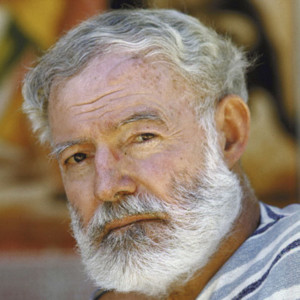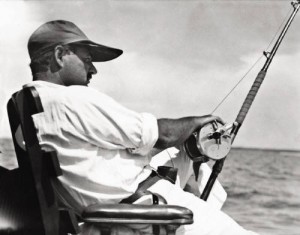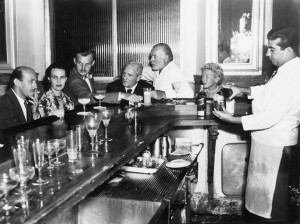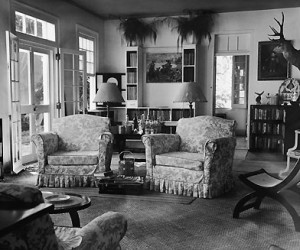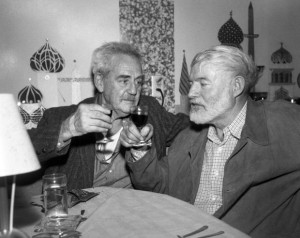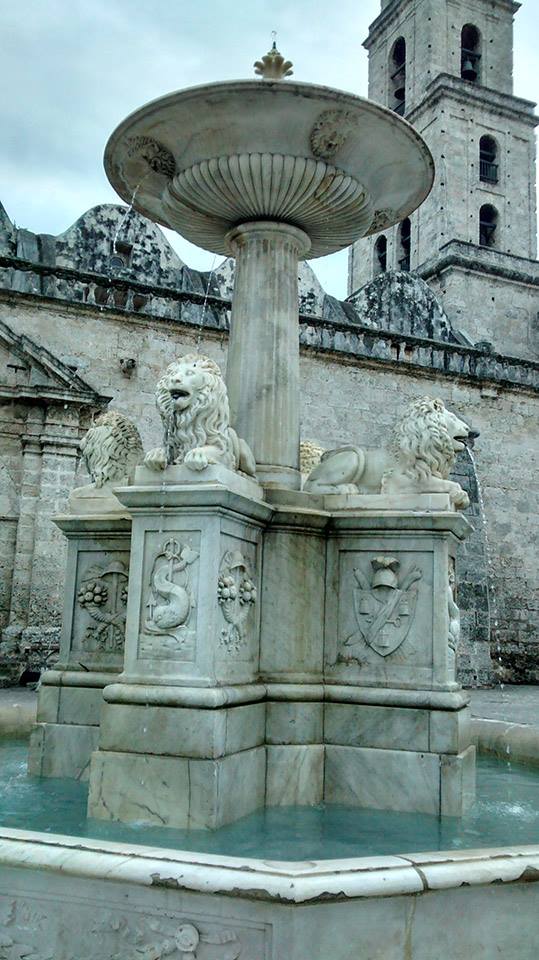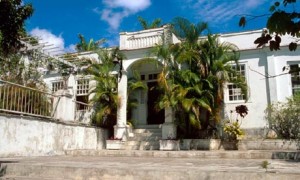ERNEST HEMINGWAY, HIS HAVANA.
Ernest Hemingway lived in this house the last 22 years of his life. When installed in the Finca La Vigia, about 30 minutes from downtown Havana, was about to conclude ‘For Whom the Bell Tolls’. To abandon it forever, and as a writer had traveled the road to fame and earned the Nobel Prize. On the farm were then his Royal portable, the graves of his dogs, about 50 cats and nine thousand books he treasured throughout his life and many years after García Márquez would exclaim: “What was the weirdest library man! ”
Hemingway came to Cuba in the first half of April 1928. Along with Pauline Pfeiffer, his second wife, made the transition here to Key West where he would end Farewell to Arms. He returned in 1932 for marlin fishing in Cuban waters. He returned in 1933 and wrote the first of his chronicles of the Cuban issue. Since then no it would break off ever in this “Long Island, beautiful and unhappy,” as he called Cuba in Green Hills of Africa. The Old Man and the Sea (1952) is, par excellence, the novel “Cuba” by Hemingway. Part of the plot of Islands in the Stream (1970) takes place in Cuba. Also in the odd story and in many of his articles there are allusions to the island’s scenario Have and Have Not (1937) is largely Cuban.
Once stated, with respect to Cuba: “I love this country and I feel at home and where a man feels at home, apart from the birthplace, that is the site that was intended.”
BY BISHOP STREET
Hemingway was in the 30s, a tourist suspiciously repeat every year spent in Cuba during May, June and July, which are those of the running of the needle.
His first refuge was Havana Hotel Ambos Mundos on Obispo Street, near the port. The room then no number on the fifth floor of that facility, which stayed invariably intact. At five o’clock, after a day of fishing, Hemingway was in her room, asked the food and began to write. What was in bed by hand and then typing the manuscript without entering corrections only. In 1958, in his famous interview with George Plimpton, recalled: “The Ambos Mundos in Havana, was a good place to work.”
By his account “The marlin fishing at the height of the hill”, with which he returned to journalism after having stayed away from the profession for over ten years, are known not a few of the customs of that host of Both Worlds.
He slept with his feet toward the east. That way the sun, as it began to hit the face, forced him to leave his bed. Then from the window, scanned the environment: the Cathedral, the harbor entrance, Casablanca, the roofs of buildings. The Cuban flag waving in the Morro he indicated the wind direction and sea curls made him suddenly realize if the trade winds blowing early. The conditions were favorable for fishing then the needle and the narrator, after showering, put on an old khaki pants, a shirt either, dry moccasins and down to breakfast, a glass of Vichy water, cold milk and other a slice of bread before heading to the boat.
Sometimes in shorts, slippers Basque, almost always without socks and a light shirt, he was seen walking down the street Obispo. Islands in the Gulf evoke the characteristic odor of that approach: the flour sacks and stored in the dust of flour, packing boxes of newly opened, the smell of roasted coffee, “which was a stronger sense that of a morning drink, “the delicious smell of snuff …
The writer felt at home in both worlds, so central to the area and the proximity to the harbor where your yacht anchored. But Martha Gellhorn, his third wife, the room began to bother anonymous and impersonal and lack of privacy during the visit of the friends of the husband. It was she who sought and found Finca Vigia. Hemingway, at the beginning, I disliked the place: it was too far from the Floridita.
“ONE LIVES IN THIS ISLAND”
Much of Islands in the Stream is set in the Havana bar. On those pages of the novel, the reader sees a character wandering whom the writer calls Lil honest. In real life called Leopoldina, a mulatto prostitute who “made life” in the Floridita and was the great love Cuban novelist. The recall in Islands in the Stream: “I had a beautiful smile, beautiful dark eyes and black hair … gorgeous skin had a smooth, ivory colored an olive tree, if such existed ivory with a slight pink hue …”
The Terrace, seafood restaurant of the fishing village of Cojimar, was in Havana, another Hemingway favorite sites. Floridita is revered in the place where the writer used to sit, the first chair on the left of the bar and The Terrace, his usual table in the left corner by the window.
“It’s nice to be here,” says the protagonist in the Gulf Islands in reference to The Terrace. And in the same novel describes the daiquiri with flavor and color accurate. “Swallow Shallow Water,” Hemingway defined it.
In 1949, said in a chronicle the reasons for his long stay in Cuba. He spoke, of course, the Gulf Stream, “where the best and most abundant fish I’ve seen in my life,” the 18 kinds of mango were harvested on their property, their breeding and fighting cocks … said casually: “You live on this island (…) because in the cool of the morning can work better and more comfortably than anywhere else.”
They finished For Whom the Bell Tolls and wrote Across the River and Into the Trees, The Old Man and the Sea, A Moveable Feast and Islands in the Gulf. Also another unfinished novel, The Garden of Eden. And also many articles and columns for periodicals, including the story A bloody summer, about the duel between the bullfighters Antonio Ordonez and Luis Miguel Dominguin, he witnessed in Spain the previous year, and that, say his biographers, had many difficult to conclude.
“I always had good luck writing in Cuba … expressed in a letter. And shortly after learning he had won the Nobel Prize, said in an interview: “This is a prize that belongs to Cuba, because my work was designed and created in Cuba, with my people of Cojimar, where I am citizen. Through all the translations present this adopted country where I have my books and my house. ”
In a newspaper article of 1936, Hemingway was in less than 200 words the story unfold years later in The Old Man and the Sea. Scholars agree that was inspired by a fisherman from Cojimar called Anselmo Hernandez, does not exclude that other local fishermen bring items to your character. The story of the novel is known. Its meaning is quite obvious. Hemingway puts into the mouth of Santiago, the protagonist: “Man is not made for defeat. A man can be destroyed but not defeated. ” The setting of the novel is the sea, and the struggle of old against the Sharks ending snatching their catch, is the man for life. I would say the writer: “I tried to make a real old, a real boy, a real sea, a real fish and real sharks. But if I did well and true enough, can mean many things. When you write well and with sincerity of a thing, that thing mean then many other things. ” And say without modesty or ambaje with The Old Man and the Sea “is as if he had finally given expression to what we chased all my life.”
He wrote up, and in recent years, a lesser kudu skin, because it “thought more clearly.” He rose early and left his work only when he reached a point where they knew exactly what would happen next. Achieve, during a day, about 500 words “clean” was satisfactory to him, never rushing directly to machine the most difficult passages, but the talks.
Finca Vigia was, says García Márquez, the only truly stable home that the writer had in his life. Mary Welsh, his fourth and last wife, got as far as he could, order in the estate and the existence of the novelist. As he complained about how much importuning visitors, Mary ordered the construction of the three-story tower next to the house. The top floor would be Hemingway’s workroom. He went up one day and stayed there for fifteen minutes, during which he tried in vain to write a sentence. Dropped and never again use the site to write. He said he could not stand the solitude.
HARAKIRI WITH RIFLE.
“Look how I’m going to kill me,” he told his friends at Finca Vigia. Placed the butt of his rifle Mannlicher Schoenauer 265 in the floor and rested the barrel on the roof of the mouth. Then pressed the trigger with the thumb of one foot. There was a sharp crack. Exclaimed with a smile: “This is the technique of harakiri with a rifle.”
At his death, was read in Havana Hemingway’s will. Among other legacies, pierced the Cuban state-owned Finca Vigia. The old writer, so reluctant to receive writers at home, wanted the property became a meeting place for young intellectuals and artists that worked there and also a center for botanical studies. Fidel Castro, who admired Hemingway and who knew him personally during one of the fishing tournaments of the needle which organized the writer, then proposed that the estate became a museum, a suggestion accepted the widow of the narrator.
But more than a museum, Finca Vigia is still the home of Hemingway. Seems empty, yet full of life. It appears that your landlord is not dead, but absent from one moment to another return from Floridita or a hunt.
Then let his rifle somewhere and look over the correspondence, in short, in the table in the library of the property there is a rubber stamp that says, “I never write letters.” Ingest a drink (“A good whiskey is very nice, is one of the nicest things of life”) and placed at his Royal portable for further work on the rare and ambitious novel that never end.
CiroBianchiRoss / InternetPhotos /www.TheCubanHistory.com
The Cuban History, Hollywood.
Arnoldo Varona, Editor.
LA HABANA DE HEMINGWAY
Ernest Hemingway vivió en esta casa los últimos 22 años de su vida. Cuando se instaló en la Finca La Vigía –a unos 30 minutos del centro de La Habana- estaba a punto de concluir ‘Por quién doblan las campanas’. Al abandonarla para siempre, había recorrido ya como escritor el camino de la fama y merecido el Premio Nobel. En la finca quedaron entonces su Royal portátil, las tumbas de sus perros, unos 50 gatos y los nueve mil volúmenes que atesoró a lo largo de su vida y que muchos años después harían exclamar a García Márquez: “¡Qué biblioteca más rara tenía este hombre!”
Hemingway llegó a Cuba en la primera quincena de abril de 1928. Junto a Pauline Pfeiffer, su segunda esposa, hizo aquí el tránsito para Cayo Hueso, donde concluiría Adiós a las armas. Volvió en 1932 para pescar agujas en las aguas cubanas. Regresó en 1933 y escribió la primera de sus crónicas de tema cubano. A partir de entonces no se desvincularía jamás de esta “isla larga, hermosa y desdichada”, como llamó a Cuba en Las verdes colinas de África. El viejo y el mar (1952) es, por excelencia, la novela “cubana” de Hemingway. Parte de la trama de Islas en el golfo (1970) transcurre en Cuba. También en alguno que otro cuento y en muchísimos de sus artículos periodísticos hay alusiones a la Isla. El escenario de Tener y no tener (1937) es cubano en buena medida.
En una ocasión expresó con relación a Cuba: “Amo este país y me siento como en casa; y allí donde un hombre se siente como en casa, aparte del lugar donde nació, ese es el sitio al que estaba destinado”.
POR LA CALLE OBISPO
Hemingway era, en la década de los 30, un turista sospechosamente reincidente que todos los años pasaba en Cuba los meses de mayo, junio y julio, que son los de la corrida de la aguja.
Su primer refugio habanero fue el hotel Ambos Mundos, en la calle Obispo, muy cerca del puerto. La habitación entonces sin número del quinto piso de esa instalación, en la que se alojó invariablemente, se conserva intacta. A las cinco de la tarde, después de un día de pesquería, Hemingway se encerraba en su pieza, pedía la comida y se ponía a escribir. Lo hacía en la cama, a mano, y luego mecanografiaba el manuscrito sin introducir apenas correcciones. En 1958, en su célebre entrevista con George Plimpton, recordaría: “El Ambos Mundos, en La Habana, fue un buen lugar para trabajar”.
Por su crónica “La pesca de la aguja a la altura del Morro”, con la que volvió al periodismo luego de haberse mantenido alejado de esa profesión durante más de diez años, se conocen no pocas de las costumbres de aquel huésped del Ambos Mundos.
Dormía con los pies hacia el levante. De esa forma el sol, cuando empezaba a golpearle la cara, lo obligaba a abandonar la cama. Entonces, desde la ventana, oteaba el entorno: la Catedral, la entrada del puerto, Casablanca, los tejados de los edificios. La bandera cubana que ondea en el Morro le indicaba la dirección del viento y los rizos del mar lo hacían percatarse de golpe si los alisios soplaban desde temprano. Las condiciones eran favorables entonces para la pesca de la aguja y el narrador, tras ducharse, se ponía un viejo pantalón de caqui, una camisa cualquiera, unos mocasines secos y bajaba a desayunar –un vaso de agua de Vichy, otro de leche fría y una rebanada de pan- antes de dirigirse a la embarcación.
A veces en bermudas, con zapatillas vascas, casi siempre sin calcetines y con una camisa ligera, se le veía caminar por la calle Obispo. En Islas en el golfo evocaría los olores característicos de esa vía: el de la harina almacenada en sacos y el del polvo de harina, el de las cajas de embalaje recién abiertas, el del olor del café tostado, “que era una sensación más fuerte que la de un trago por las mañanas”, el delicioso olor a tabaco…
El escritor se sentía a gusto en el Ambos Mundos, por lo céntrico de la zona y la cercanía con el puerto, donde fondeaba su yate. Pero a Martha Gelhorn, su tercera esposa, comenzaron a incomodarle la habitación anónima y despersonalizada y la falta de privacidad ante la visita de los amigos del marido. Fue ella la que buscó y encontró Finca Vigía. A Hemingway, al inicio, le desagradó el lugar: quedaba demasiado lejos del Floridita.
UNO VIVE EN ESTA ISLA
Una buena parte de Islas en el golfo transcurre en ese bar habanero. En esas páginas de la novela, el lector ve deambular a un personaje a quien el escritor llama Liliana la honesta. En la vida real se llamó Leopoldina, una prostituta mulata que “hacía la vida” en el Floridita y que fue el gran amor cubano del novelista. La recordaría en Islas en el golfo: “Tenía una hermosa sonrisa, unos ojos oscuros maravillosos y espléndido pelo negro… Tenía un cutis terso, como un marfil color olivo, si tal marfil existiera, con un ligero matiz rosado…”
La Terraza, restaurante marinero del pueblo de pescadores de Cojímar, fue, en La Habana, otro de los sitios preferidos de Hemingway. En el Floridita se reverencia el sitio donde el escritor solía sentarse –la primera butaca de la izquierda de la barra- y en La Terraza, su mesa de siempre, en la esquina izquierda, junto a la ventana.
“Es muy agradable estar aquí”, dice el protagonista de Islas en el golfo en alusión a La Terraza. Y en la misma novela se describe al daiquiri con su sabor y color exactos. “Trago de aguas someras”, lo definía Hemingway.
En 1949, explicó en una crónica las razones de su larga residencia cubana. Habló, por supuesto, de la Corriente del Golfo, “donde hay la mejor y más abundante pesca que he visto en mi vida”; de las 18 clases de mango que se cosechaban en su propiedad, de su cría de gallos de pelea…y apuntó como al descuido: “Uno vive en esta Isla (…) porque en el fresco de la mañana se trabaja mejor y con mayor comodidad que en cualquier otro sitio.”
Allí concluyó Por quien doblan las campanas y escribió A través del río y entre los árboles, El viejo y el mar, París era una fiesta e Islas en el golfo. También otra novela que dejó inconclusa, El jardín del Edén. Y asimismo muchísimos artículos y crónicas para publicaciones periódicas, entre ellos el reportaje Un verano sangriento, acerca del mano a mano entre los toreros Antonio Ordóñez y Luis Miguel Dominguín, que presenció en España el año precedente, y que, dicen sus biógrafos, tuvo muchas dificultades para poder concluir.
“Yo siempre tuve buena suerte escribiendo en Cuba… expresó en una carta. Y poco después de conocer que había ganado el Premio Nobel, declaró en una entrevista: “Este es un Premio que pertenece a Cuba, porque mi obra fue pensada y creada en Cuba, con mi gente de Cojímar, de donde soy ciudadano. A través de todas las traducciones está presente esta patria adoptiva donde tengo mis libros y mi casa”.
En una crónica periodística de 1936, Hemingway contó en menos de 200 palabras la historia que desplegaría años después en El viejo y el mar. Los estudiosos coinciden que se inspiró en un pescador de Cojímar llamado Anselmo Hernández, lo que no excluye que otros pescadores de la zona aportaran elementos a su personaje. La anécdota de la novela es conocida. Su sentido es bien evidente. Hemingway lo pone en boca de Santiago, el protagonista: “El hombre no está hecho para la derrota. Un hombre puede ser destruido, pero no derrotado”. El escenario de la novela es el mar, y la lucha del viejo contra los tiburones que terminan arrebatándole su pesca, es la del hombre por la vida. Diría el escritor: “Traté de hacer un viejo real, un muchacho real, un mar real, un pez real y tiburones reales. Pero si los hice bien y suficientemente verdaderos, pueden significar muchas cosas. Cuando se escribe bien y con sinceridad de una cosa, esa cosa significará después muchas otras cosas”. Y dirá sin ambaje ni modestia que con El viejo y el mar “es como si finalmente hubiera dado expresión a lo que perseguí toda mi vida”.
Escribía de pie, ya en los últimos años, sobre una piel de lesser kudú, porque así “pensaba con más claridad”. Se levantaba temprano y solo abandonaba su labor cuando llegaba a un punto en que sabía con exactitud lo que sucedería después. Lograr, durante una jornada, unas 500 palabras “limpias” era para él satisfactorio, y jamás acometía directamente a máquina los pasajes más difíciles, pero sí los diálogos.
Finca Vigía fue, dice García Márquez, la única casa verdaderamente estable que el escritor tuvo en su vida. Mary Welsh, su cuarta y última esposa, puso, hasta donde pudo, orden en la finca y en la existencia del novelista. Como éste se quejaba de cuánto lo importunaban los visitantes, Mary dispuso la construcción de la torre de tres pisos aledaña a la casa. La última planta sería el cuarto de trabajo de Hemingway. Subió un día y permaneció allí quince minutos, durante los cuales se empeñó, en vano, en redactar una frase. Bajó y nunca más volvió a utilizar el sitio para escribir. Comentó que no podía resistir la soledad.
HARAKIRI CON FUSIL
“Miren como voy a matarme”, decía a sus amigos en Finca Vigía. Colocaba la culata de su escopeta Mannlicher Schoenauer 265 en el piso y apoyaba el cañón en el cielo de la boca. Luego oprimía el gatillo con el pulgar de un pie. Se oía un chasquido seco. Exclamaba sonriente: “Esta es la técnica del harakiri con fusil.”
A su muerte, se leyó en La Habana el testamento de Hemingway. Entre otros legados, traspasaba al Estado cubano la propiedad de Finca Vigía. El viejo escritor, tan remiso a recibir a escritores en su casa, quería que el predio se convirtiera en lugar de reunión de jóvenes intelectuales y artistas y que funcionase allí además un centro de estudios botánicos. Fidel Castro, que admiraba a Hemingway y que lo conoció personalmente durante uno de los torneos de la pesca de la aguja que organizaba el escritor, propuso entonces que la finca se convirtiera en museo, sugerencia que aceptó la viuda del narrador.
Pero más que un museo, Finca Vigía continúa siendo la casa de Hemingway. Vacía parece, sin embargo, llena de vida. Da la impresión de que su propietario no está muerto, sino ausente y que de un momento a otro regresará del Floridita o de una cacería.
Dejará entonces en algún sitio su carabina y mirará por encima la correspondencia; en definitiva, en la mesa de la biblioteca de la finca hay un cuño de goma que dice: “Yo nunca escribo cartas”. Ingerirá un trago (“Un buen güisqui es muy agradable, es una de las cosas más agradables de la existencia”) y se colocará ante su Royal portátil para proseguir el trabajo en la rara y ambiciosa novela que nunca llegó a concluir.
CiroBianchiRoss / InternetPhotos /www.TheCubanHistory.com
The Cuban History, Hollywood.
Arnoldo Varona, Editor.



 ERNEST HEMINGWAY, His Havana. + LA HABANA de Ernest Hemingway.
ERNEST HEMINGWAY, His Havana. + LA HABANA de Ernest Hemingway.